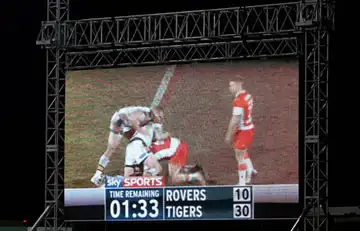Could Thursdays spell the end to Super League on Sundays?

Thursday night rugby league continues to divide opinion, but could it spell the end to Super League games on a Sunday?
Widnes coach Denis Betts made the suggestion at his weekly press conference, in between a short turnaround for his side between their win over Hull KR last weekend and their televised defeat to Salford on Thursday.
Perhaps the better suggestion might have been that Widnes should have made the move to re-arrange their game prior to a televised clash, as a couple of other clubs – notably Castleford and Salford – already have done this term.
Thursday’s have of course been forced upon us by Sky Sports, scrapping the traditional Saturday evening slot, although coverage of Catalans’ home games has maintained at least some coverage.
The move basically spelled the end of any live Championship coverage.
But has it benefited the game at all?
Of the seven games televised live on a Thursday so far this season, only two have recorded increases on the equivalent fixture in 2014 – ironically, the two involving Widnes. Their opener with Wigan attracted a crowd of 9286, some 3063 more than the same fixture last season; albeit it was largely assisted by a world record attempt earlier in the day. The game against Salford on Thursday also attracted 208 more fans than last season.
Of course, attendances are always hard to compare due to the sheer number of variables that can affect them – day, kick-off time, weather, club’s performance, other events, whether it’s on TV or not, the general state of the game in general, and many more.
But we’ve had a look anyway.
Of the 21 televised Thursday night matches in 2014 (excluding Easter weekend and the play-offs), only four recorded higher attendances than the equivalent game in 2013 – Salford v St Helens (6,353 v 3,248), Castleford v Leeds (9,208 v 9,103), Hull KR v Huddersfield (8,953 v 6,963) and Wigan v Salford (12,962 v 12,489).
In total, attendances across the equivalent games dropped 12% from being played on a Thursday night compared to the previous season (where the games were played on Friday nights, Saturdays, Sundays or Monday nights). Average attendance down from 9910 to 8784.
Interestingly, the fixtures that were televised on Monday nights in 2013 attracted better crowds than when they were televised on Thursday nights in 2014 – Warrington v Wigan (14,028 v 11,550), Wakefield v Widnes (7,543 v 3,932) and Hull KR v Wigan (7,894 v 6,801).
This season’s clash between St Helens and Warrington played on Thursday March 19 attracted a crowd of 12,618 – down 236 from last season’s game, also on a Thursday (September 4) – but perhaps more significantly, down 2,095 from the previous season’s game on Friday August 30 2013; and down 3,110 from Monday August 6 2012.
The two regular season games between Wigan and Warrington were televised on Thursdays last season, resulting in a loss of 6,872 fans across the two games compared to 2013, when the games were played on a Monday and Friday.
It’s hard to say definitively whether Thursday night games are having a detrimental effect on attendances, and given that the game relies so heavily on the financial input of Sky, it will almost always be at the mercy of the broadcaster.
Denis Betts’ suggestion of scrapping Sunday’s would ensure the Super League weekend is covered within three days, and would remove the issue of turnaround and player welfare.
It could also mean greater focus and attention is given to the Championship and League One on a Sunday, perhaps even enabling some sort of television coverage. It seems backwards that in the day and age where more and more sport is accessible, we actually see less live televised rugby league than we did five or six years ago.
From another viewpoint, the late kick-offs on Thursday and Friday night are not the best for getting media coverage in the following day’s papers, although whether that’s the only reason is another usual hot discussion amongst fans.
For now, it seems Thursdays are here to stay – whether the same can be said for Sundays, remains to be seen.